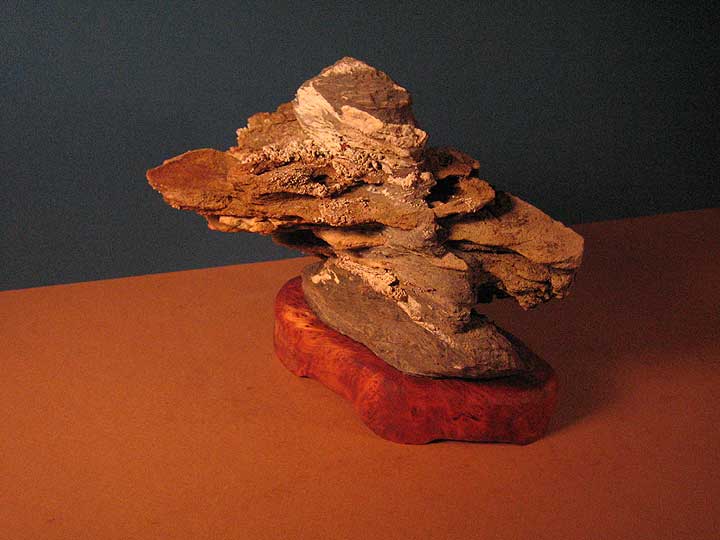Related
GLOSSARY OF CHINESE SUISEKI TERMINOLOGY
Baojing. Surface coating from exposure to air or touching, a mark of antiquity, enhances value of stones
Baoshi. Gemstones.
Bayinshi. Resonant rocks. (See Lingbi Rocks).
Changhua Stones or rocks found at Changhua, Zhejiang Province. Soapstone.
Chou. Ugly, but with a charm and distinction.
Dalishi. Marble.
Duanshi. Duan stones.
Fenglishi or Fonglishi. Stones found in the provinces of Xinjiang, Inner Mongolia and the Gobi desert of Ganxu, display natural wearing action of the desert winds and sand, usually light in color.
Gan. Dry surface texture.
Gongshi. Scholar rock miniature garden rock displayed and appreciated indoors.
Gu. Ancient, appealing, elegant.
Guai. Unusual or strange, added favorable connotation of wonderful, special, interesting. (See qi and yi).
Guaishi. Fantastic rocks. Before the 20th century, used for both garden and studio rocks. (See qishi and yishi).
Hongheshi. Red River rocks, found in the Red River, Guanxi province.
Huanglashi. Yellow Wax Rocks, found in Guangdong or Guangxi Provinces, have surfaces that appear melted, with a naturally polished wax surface, found in riverbeds sandstone, jasper, or andesite with silica.
Jue. Matchless or peerless.
Juhuashi. Chrysanthemum stone.
Jui. Old.
Kongqushi. Malachite.
Kunshi. Rocks found in Kunshan, Jiangsu province, from siliceous liquid which filled holes and fissures of dolomite to form crystals.
Laoshan lushi. Laoshan green stones.
Lingbishi. Black limestone medium gray limestone, eroded but without perforations buff limestone green limestone with peaks, grottos, stalactites and stalagmites, many colors and types, most famous are dark, some have traces of red clay in bases, often have resonance, surfaces grooved and channeled from erosion of slow-moving water. Original cave rocks are dark gray or black.
Lingshi. Rocks found in Lingbi, Anhui province.
Lou. Channels and other types of indentations.
Lusongshi. Turquoise.
Mingsheng qishi. Rocks collected as souvenirs of sacred mountains, famous geographical locations or historic places.
Muhuashi. Petrified wood.
Muhushi. Black ying rocks.
Penjing. Basin scene. Verticle stones used to depict mountains and set into a basin or tray. In China, many things can be added to these rocks to create other types of penjing. Often added are soil, sand, living trees, and miniature clay figures of people, houses, bridges, and boats.
Pingdan. Sparse or unassertive.
Pu. Natural, simplistic.
Qi. Unusual or strange, with the added and favorable connotation of interesting, wonderful and special. (See also guai and yi).
Qilian rocks or stones. Rocks found at Mount Qilian, Gansu Province. Black limestone.
Qingrun. Clear and moist. Considered to be the perfect degree of surface luster between glossy and matte.
Qingyue. Pure and surpassing.
Qishi. Fantastic rocks. Before the 20th century, used for both garden and studio rocks. (See also guaishi and yishi).
Qixiashi. Qixia stones.
Qixing. Fantastic shapes.
Run. Moist (as in surface texture).
Se. Color.
Shangshi. Admirable rocks. Rocks identified by qualities admirers saw in them.
Shankeng. Mountain deposits. Stones found in the mountains or at the base of mountains.
Shen. Spirit.
Sheng. Resonance.
Shih. Stone.
Shou. Thin, vertical and slender.
Shoushanshi. Rocks found at Shoushan, Fujian Province. Mottled yellow soapstone or golden silica in the form of quartz. Shoushan stones are divided into three catagories according to presumed source field, water, or mountain deposits. They are often further divided based on color and internal markings.
Shuikeng. Water deposits. Stones found in lakes or rivers.
Taihu rocks or stones. Rocks found in Lake Tai, Jiangsu Province. White perforated limestone with significant erosion. Also black limestone. Wuxi, Zheijiang Province. Swiss cheese appearance with many holes. Limestone, but lighter in color than Lingbi or Ying Shih.
Tiankeng. Field deposits. Stones found in fields areas between the mountains and the rivers or lakes.
Tou. Holes and Openness. Also refers to indentations that are not holes.
Wan. Stubborn.
Wanshi. Stubborn rocks. Rocks identified by qualities admirers saw in them.
Wen. Texture.
Wenfang yashi. Scholars rocks or “elegant stones for the scholars studio”.
Wenya. Literary elegance sparse elegance of the scholars studio.
Wucai. Multi-colored.
Xing. Shape.
Xiu. Elegant, refined, polished.
Yantai. Inkstones.
Yashi. Elegant rocks. Rocks identified by qualities admirers saw in them.
Yi. Unusual or strange, with the added and favorable connotation of interesting, wonderful and special. (See also guai and qi).
Yingde rocks or stones. Rocks found in Yingde, Guangdong Province. Black limestone perforated with peaks and grottos dark gray Ying limestone. Ying shih rocks dark gray limestone, grooved or channeled and striated. Distinctive surface dimpled and pock-marked.
Yishi. Fantastic rocks. Before the 20th century, used for both garden and studio rocks. (See also guaishi and qishi).
Yu. Jade.
Yuanlin lifeng. Garden Rocks or “upright peaks for the garden”.
Yung river stones. Stones found in Yung river, Hunan Province. Most noted for Chrysanthemum stones.
Zhauqing rocks or stones. Rocks found at Zhauqing, Guangdong Province. Off-white limestone with multiple perforations.
Zhi. Material.
Zhou. Wrinkles, deep furrows, relief ridges or intaglio lines.
Zhuo. Clumsy.
Zibowen rocks. Wen rocks found in Zibo, Shandong province. Composed of lime, granite. Aragonite forms are usuallly black and very hard.

